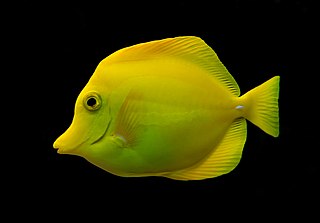
The yellow tang, also known as the lemon sailfin, yellow sailfin tang or somber surgeonfish, is a species of marine ray-finned fish belonging to the family Acanthuridae which includes the surgeonfishes, unicornfishes and tangs. It is one of the most popular marine aquarium fish. It is bright yellow in color, and it lives in reefs. The yellow tang spawn around a full moon. The yellow tang eats algae. The yellow tang has a white barb, located just before the tail fin, to protect itself.

Chard or Swiss chard is a green leafy vegetable. In the cultivars of the Flavescens Group, the leaf stalks are large and often prepared separately from the leaf blade; the Cicla Group is the leafy spinach beet. The leaf blade can be green or reddish; the leaf stalks are usually white, yellow or red.

The yellow perch, commonly referred to as perch, striped perch, American perch or preacher is a freshwater perciform fish native to much of North America. The yellow perch was described in 1814 by Samuel Latham Mitchill from New York. It is closely related, and morphologically similar to the European perch ; and is sometimes considered a subspecies of its European counterpart.

The plains pocket mouse is a heteromyid rodent of North America. It ranges from southwestern Minnesota and southeastern North Dakota to northern Texas east of the Rockies, and from northern Utah and Colorado to northern Chihuahua west of the Rockies.
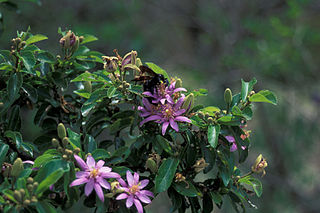
Grewia is a large flowering plant genus in the mallow family Malvaceae, in the expanded sense as proposed by the Angiosperm Phylogeny Group. Formerly, Grewia was placed in either the family Tiliaceae or the Sparrmanniaceae. However, these were both not monophyletic with respect to other Malvales - as already indicated by the uncertainties surrounding placement of Grewia and similar genera - and have thus been merged into the Malvaceae. Together with the bulk of the former Sparrmanniaceae, Grewia is in the subfamily Grewioideae and therein the tribe Grewieae, of which it is the type genus.

The yellow mud turtle, also commonly known as the yellow-necked mud turtle, is a species of mud turtle in the family Kinosternidae. The species is endemic to the Central United States and Mexico.
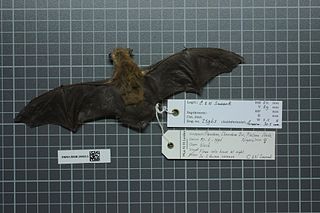
Neoromicia is a genus of vesper bat in the family Vespertilionidae. It contains the following species:
The yellow serotine is a species of vesper bat. It is found in Angola, Burundi, Cameroon, Malawi, and Mozambique. Its natural habitats are subtropical or tropical forests and savanna.
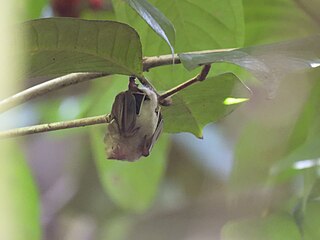
The Jamaican fig-eating bat is a species of bat in the family Phyllostomidae. It is the only living species in the genus Ariteus. The scientific name translates as "yellowish and warlike". There are no recognised subspecies.
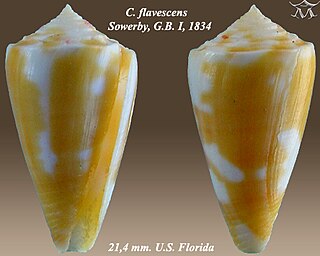
Conus flavescens, common name the flame cone, is a species of sea snail, a marine gastropod mollusk in the family Conidae, the cone snails and their allies.

Trisetum flavescens, the yellow oatgrass or golden oat grass, is a species of grass in the family Poaceae. It is native to Europe, Asia, and North Africa.
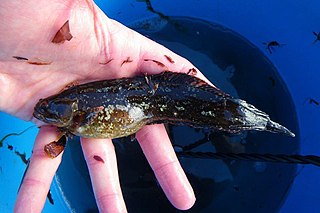
The short-tassel weedfish is a species of clinid native to the Pacific Ocean waters around the Bass Strait and New Zealand. This species are known to feed on fishes and benthic crustaceans. It is the only species in its genus. Klunzinger's name, Clinus marmoratus, is a homonym and was preoccupied by Castelnau's Clinus marmoratus, rendering it invalid for this fish and this name is now considered to be a junior synonym of Cologrammus flavescens.
Phyllotrox is a genus of true weevils in the beetle family Curculionidae. There are at least 60 described species in Phyllotrox.
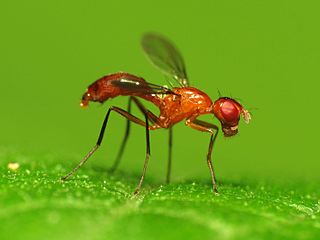
Sepsisoma is a genus of flies in the family Richardiidae. There are about 13 described species in Sepsisoma.

Anthidiellum is a genus of rotund resin bees in the family Megachilidae. There are more than 60 described species in Anthidiellum.
Triaenodes flavescens is a species of long-horned caddisfly in the family Leptoceridae. It is found in North America.

Brachymyrmex depilis is a species of Formicine ant native to North America.

Agnetina flavescens, the midwestern stone, is a species of common stonefly in the family Perlidae. It is found in North America.
Titiotus flavescens is a species of false wolf spiders & wandering spiders in the family Zoropsidae. It is found in the United States.
Heptagenia flavescens is a species of flatheaded mayfly in the family Heptageniidae. It is found in Central America and North America.

















